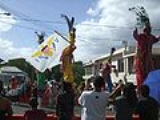
Moko jumbie
Encyclopedia

Jumbee
A Jumbee, Jumbie or Mendo is a type of mythological spirit or demon in the folklore of some Caribbean countries. Jumbee is the generic name given to all malevolent entities; however, there are numerous kinds of jumbees, that reflect the Caribbean’s complex history and ethnic makeup, drawing on...
", a West Indian term for a ghost or spirit that may have been derived from the Kongo language
Kongo language
The Kongo language, or Kikongo, is the Bantu language spoken by the Bakongo and Bandundu people living in the tropical forests of the Democratic Republic of the Congo, the Republic of the Congo and Angola. It is a tonal language and formed the base for Kituba, a Bantu creole and lingua franca...
word zumbi
Zumbi
Zumbi , also known as Zumbi dos Palmares, was the last of the leaders of the Quilombo dos Palmares, in the present-day state of Alagoas, Brazil.-Quilombos:...
. The Moko Jumbies are thought to originate from West African tradition brought to the Caribbean.
A Moko Jumbie character may wear colorful garb and carnival masks. They also frequent festivals and celebrations such as Trinidad and Tobago Carnival
Trinidad and Tobago Carnival
The Trinidad and Tobago Carnival is an annual event celebrated on the Monday and Tuesday before Ash Wednesday.Carnival in Trinidad and Tobago is the most significant event on the islands' cultural and tourism calendar, with numerous cultural events running in the lead up to the street parade on...
.
While the god Moko is from the Kongo
Kongo people
The Bakongo or the Kongo people , also sometimes referred to as Kongolese or Congolese, is a Bantu ethnic group which lives along the Atlantic coast of Africa from Pointe-Noire to Luanda, Angola...
(or Congo) and Nigeria
Nigeria
Nigeria , officially the Federal Republic of Nigeria, is a federal constitutional republic comprising 36 states and its Federal Capital Territory, Abuja. The country is located in West Africa and shares land borders with the Republic of Benin in the west, Chad and Cameroon in the east, and Niger in...
, from the Nuapa people, Trinidad and Tobago
Trinidad and Tobago
Trinidad and Tobago officially the Republic of Trinidad and Tobago is an archipelagic state in the southern Caribbean, lying just off the coast of northeastern Venezuela and south of Grenada in the Lesser Antilles...
has added their own touch to him. Moko, in the traditional sense, is a god. He watches over his village, and due to his towering height, he is able to foresee danger and evil. His name, Moko, literally means the “diviner” and he would be represented by men on towering stilts and performs acts that were unexplainable to the human eye. In one remote tribe, the Moko rises from a regular mans’ height to the skies fluidly with no help and descends similarly to leave others to wonder how he performed such an act.
The Moko arrived in Trinidad by “walking all the way across the Atlantic Ocean from the West coast of Africa, laden with many, many centuries of experience, and, in spite of all inhuman attacks and encounters, yet still walks tall, tall, tall. (John Cupid, Caribbean Beat)” The idea of the Moko survived by living in the hearts of African descendants during slavery and colonial life to eventually walk the streets of Trinidad in a celebration of freedom, Carnival
Carnival
Carnaval is a festive season which occurs immediately before Lent; the main events are usually during February. Carnaval typically involves a public celebration or parade combining some elements of a circus, mask and public street party...
. While this figure was rooted in African heritage, Trinidad adapted the figure, notably by adding on Jumbie or ghost to the name. The by the early 1900s Moko Jumbies had become an element of Trinidad’s Carnival. This figure would walk the streets of Port of Spain
Port of Spain
Port of Spain, also written as Port-of-Spain, is the capital of the Republic of Trinidad and Tobago and the country's third-largest municipality, after San Fernando and Chaguanas. The city has a municipal population of 49,031 , a metropolitan population of 128,026 and a transient daily population...
and other cities protecting the city and revelers from evil. As part of his role in Carnival the Moko Jumbie would accept donations from onlookers in upper floors of buildings. However, his notable figure of Carnival slowly faded until a drastic revival.
By the early 1990s Moko Jumbies were essentially non-existent in Carnival, until two men brought this tradition back. These men, namely Moose and Dragon, have brought the Moko Jumbie back to a place of prominence in Carnival and created a new kind of Moko Jumbie. One man originally brought the idea to them as well as the knowledge of how to make stilts. The style of stilts they walked was very similar to the modern day ones but with one main difference, they had no front leg brace. This changed when a man named Ben Block from Canada
Canada
Canada is a North American country consisting of ten provinces and three territories. Located in the northern part of the continent, it extends from the Atlantic Ocean in the east to the Pacific Ocean in the west, and northward into the Arctic Ocean...
, a random traveler, came to Trinidad with a pair of stilts. He had a frontal brace on the upper leg and the Trinidadians took inspiration from this design and used it in their own. Now there are two main Moko Jumbie bands in Trinidad, Watusi and Kilimanjaro, as well as several smaller ones. So while the idea of the Moko came from Africa, Trinidad has made it its own.

